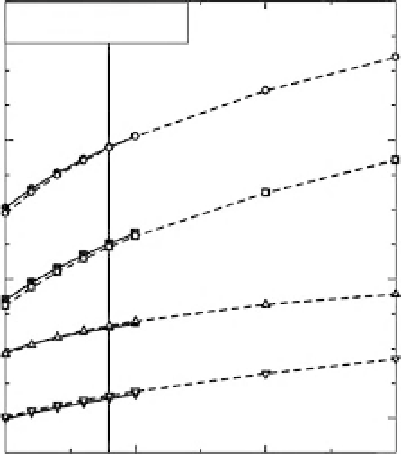Geoscience Reference
In-Depth Information
phase. This phase change yields a density jump
of
transformation from NAL-to-CF is expected to
produce insignificant variations in the seismic
velocities in the subducted basaltic aggregate due
to the small velocity contrasts and also the solid
solution phase relation. Therefore this phase
change would be seismologically undetectable.
The elastic wave velocities of these alumi-
nous phases of CF-type MgAl
2
O
4
and NaAlSiO
4
,
K-hollandite KAlSi
3
O
8
, and the NAL phase with
the NaMg
2
Al
5
SiO
12
composition range between
those of CaPv and Pv. In addition to the interme-
diate velocities, since the total volume fraction
is no more than
1.8% for the NaMg
2
Al
5
SiO
12
composition at
the static transition pressure at
+
40 GPa.
In contrast to the phase stability, elasticity of
these phases and its pressure dependence had been
unclear. A recent
ab initio
density functional
study however examined their high-pressure
elasticity with taking in to account the Na/Mg
and Al/Si cation disordering and elucidated
that the NAL-to-CF transition is accompanied
by velocity jumps of the compressional wave
(
∼
−
0.2%), shear wave (
+
0.9%), and bulk sound
20% even in MORB, these
phases have limited influences on the bulk rock
velocities. However, the velocity reduction as-
sociated with the ferroelastic phase change in
K-hollandite could potentially produce detectable
seismic signatures similarly to the post-stishovite
phase change but at much shallower depths cor-
responding to the uppermost lower mantle.
∼
(
1.0%) velocities (Kawai & Tsuchiya, 2012b)
(Figure 7.7). Although a particular composition
of NaMg
2
Al
5
SiO
12
was investigated in Kawai
and Tsuchiya (2012b), Vanpeteghem
et al
. (2003)
suggested that the elasticity of the NAL phase
do not change despite substantial variations in
cations content. Although the phase fraction is
as much as
−
20 vol% in MORB at the uppermost
lower mantle (Ricolleau
et al
., 2010), the gradual
∼
7.5
Dense Hydrous Phases
16
NaMg
2
AI
5
SiO
12
Subducted slabs also play another important role
to transport water (OH
−
) into the deep mantle (see
Chapter 13, this volume, below). Water has signif-
icant influences on geodynamic processes in the
Earth's interior, since it changes physical proper-
ties of the minerals, such as transition boundaries
between mantle phases (e.g., Chen
et al
., 2002;
Ohtani
et al
., 2004), seismic wave velocities (e.g.,
Inoue
et al
., 1998; Jacobsen
et al
., 2005; Tsuchiya
& Tsuchiya, 2009a), rheology (e.g., Chopra &
Paterson, 1984; Karato
et al
., 1986), transfor-
mation kinetics (e.g., Kubo
et al
., 1998), dif-
fusivity and electric conductivity (e.g., Karato,
1990; Wang
et al
., 2006; Yoshino
et al
., 2006).
Crustal hydrous minerals such as clays minerals,
micas, smectites, amphiboles, serpentines, chlo-
rites, etc. are the water carriers at the first stage
of subduction. They usually become unstable at
the deep mantle pressure and temperature, and
then release water to the surrounding mantle at
several GPa (e.g., Ulmer & Trommsdorff, 1995;
Ono, 1998; Pawley, 2003). Some of them can be
stored in nominally anhydrous minerals (Smyth
V
P
12
V
Φ
8
V
S
ρ
4
0
50
100
150
P (GPa)
Fig. 7.7
Static elastic wave velocities and density
calculated for the NAL phase (solid lines) and the CF
phase (dashed lines) with the NaMg
2
Al
5
SiO
12
composition as a function of pressure. A vertical line
represents the NAL-CF transition pressure.

